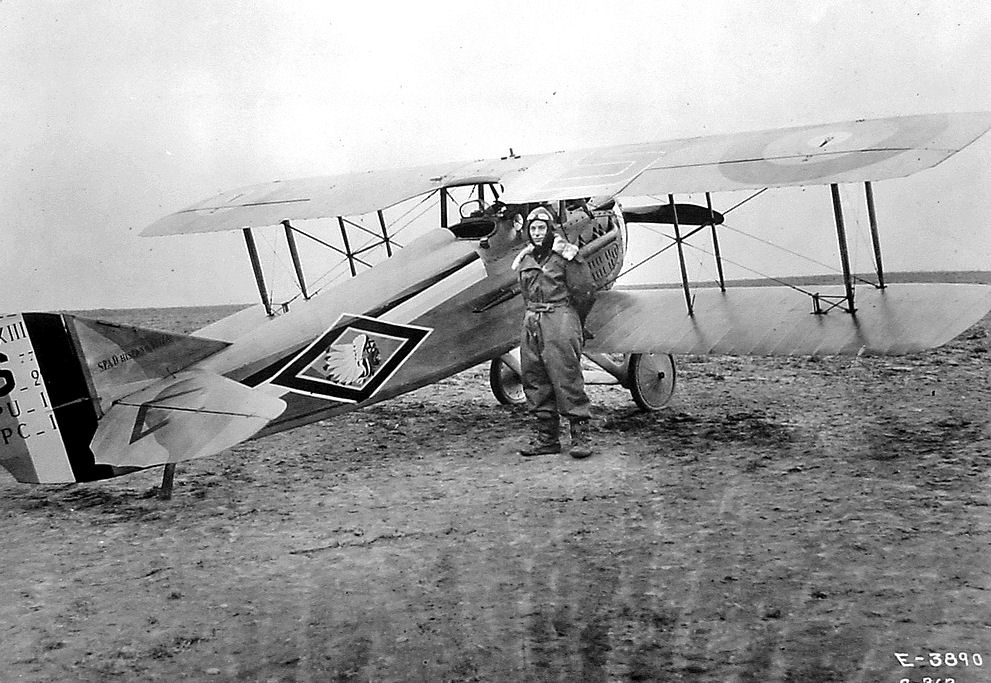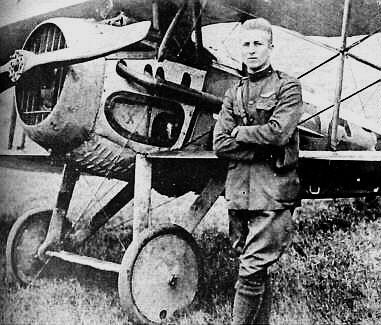|
Frank Luke Jr.
Frank Luke Jr. (May 19, 1897 – September 29, 1918) was an American fighter ace credited with 19 aerial victories, ranking him second among United States Army Air Service pilots after Captain Eddie Rickenbacker during World War I. Luke was the first airman to receive the Medal of Honor and first USAAS ace in a day. Luke Air Force Base, Arizona, a United States Air Force pilot training installation since World War II, is named in his honor. Early life and career Luke was born May 19, 1897, in Phoenix, Arizona, after his father emigrated from Germany to the United States in 1874 and settled there. Frank was his family's fifth child, and had eight brothers and sisters. He grew up excelling in sports, working in copper mines, and participating in bare-knuckle boxing matches. Following the United States' entry into World War I in April 1917, Frank enlisted in the Aviation Section, U.S. Signal Corps on September 25, 1917, and received pilot training in Texas and California. After ... [...More Info...] [...Related Items...] OR: [Wikipedia] [Google] [Baidu] |
Phoenix, Arizona
Phoenix ( ; nv, Hoozdo; es, Fénix or , yuf-x-wal, Banyà:nyuwá) is the capital and most populous city of the U.S. state of Arizona, with 1,608,139 residents as of 2020. It is the fifth-most populous city in the United States, and the only U.S. state capital with a population of more than one million residents. Phoenix is the anchor of the Phoenix metropolitan area, also known as the Valley of the Sun, which in turn is part of the Salt River Valley. The metropolitan area is the 11th largest by population in the United States, with approximately 4.85 million people . Phoenix, the seat of Maricopa County, has the largest area of all cities in Arizona, with an area of , and is also the 11th largest city by area in the United States. It is the largest metropolitan area, both by population and size, of the Arizona Sun Corridor megaregion. Phoenix was settled in 1867 as an agricultural community near the confluence of the Salt and Gila Rivers and was incorporated as a ci ... [...More Info...] [...Related Items...] OR: [Wikipedia] [Google] [Baidu] |
Luke Air Force Base
Luke Air Force Base is a United States Air Force base in Maricopa County, Arizona, United States., effective 20 December 2007 It is located west of the central business district of Glendale, and west of Phoenix. Luke AFB is a major training base of the Air Education and Training Command (AETC), training pilots in the F-16 Fighting Falcon. On 31 March 2011 it was announced that the F-35 Lightning II would replace the F-16 as the primary training aircraft at Luke, although the date of deployment of the new aircraft to Luke and reorganization plans were not announced. On 16 July 2013, the Air Force announced that Luke AFB will house a total of 144 F-35A Lightning IIs. It is a designated Superfund site due to a number of soil and groundwater contaminants. History Frank Luke Jr. Luke Air Force Base was named after Second Lieutenant Frank Luke (1897–1918). Lt Luke is a posthumous Medal of Honor recipient and the number two United States flying ace in World War I. Born ... [...More Info...] [...Related Items...] OR: [Wikipedia] [Google] [Baidu] |
Rembercourt-Sommaisne
Rembercourt-Sommaisne () is a commune in the Meuse department in Grand Est in northeastern France. Rembercourt-Sommaisne was created on 1 January 1973 when the former communes of Rembercourt-aux-Pots and Sommaisne were joined together. Geography The Chée forms part of the commune's southern border. The Aisne rises near Sommaisne, a hamlet in the northern part of the commune. See also *Communes of the Meuse department The following is a list of the 499 communes of the Meuse department of France. The communes cooperate in the following intercommunalities (as of 2020):Rembercourtsommaisne {{Meuse-geo-stub ... [...More Info...] [...Related Items...] OR: [Wikipedia] [Google] [Baidu] |
SPAD XIII
The SPAD S.XIII is a French biplane fighter aircraft of the First World War, developed by '' Société Pour L'Aviation et ses Dérivés'' (SPAD) from the earlier and highly successful SPAD S.VII. During early 1917, the French designer Louis Béchereau, spurred by the approaching obsolescence of the S.VII, decided to develop two new fighter aircraft, the S.XII and the S.XIII, both using a powerful new geared version of the successful Hispano-Suiza 8A engine. The cannon armament of the S.XII was unpopular with most pilots, but the S.XIII proved to be one of the most capable fighters of the war, as well as one of the most-produced, with 8,472 built and orders for around 10,000 more cancelled at the Armistice.Sharpe 2000, p. 272. By the end of the First World War, the S.XIII had equipped virtually every fighter squadron of the ''Aéronautique Militaire''. In addition, the United States Army Air Service also procured the type in bulk during the conflict, and some replaced or s ... [...More Info...] [...Related Items...] OR: [Wikipedia] [Google] [Baidu] |
Frank Luke
Frank Luke Jr. (May 19, 1897 – September 29, 1918) was an American fighter ace credited with 19 aerial victories, ranking him second among United States Army Air Service pilots after Captain Eddie Rickenbacker during World War I. Luke was the first airman to receive the Medal of Honor and first USAAS ace in a day. Luke Air Force Base, Arizona, a United States Air Force pilot training installation since World War II, is named in his honor. Early life and career Luke was born May 19, 1897, in Phoenix, Arizona, after his father emigrated from Germany to the United States in 1874 and settled there. Frank was his family's fifth child, and had eight brothers and sisters. He grew up excelling in sports, working in copper mines, and participating in bare-knuckle boxing matches. Following the United States' entry into World War I in April 1917, Frank enlisted in the Aviation Section, U.S. Signal Corps on September 25, 1917, and received pilot training in Texas and California. After ... [...More Info...] [...Related Items...] OR: [Wikipedia] [Google] [Baidu] |
Fokker D
Fokker was a Dutch aircraft manufacturer named after its founder, Anthony Fokker. The company operated under several different names. It was founded in 1912 in Berlin, Germany, and became famous for its fighter aircraft in World War I. In 1919 the company moved its operations to the Netherlands. During its most successful period in the 1920s and 1930s, it dominated the civil aviation market. Fokker went into bankruptcy in 1996, and its operations were sold to competitors. History Fokker in Germany At age 20, while studying in Germany, Anthony Fokker built his initial aircraft, the ''Spin'' (Spider)—the first Dutch-built plane to fly in his home country. Taking advantage of better opportunities in Germany, he moved to Berlin, where in 1912, he founded his first company, Fokker Aeroplanbau, later moving to the Görries suburb just southwest of Schwerin (at ), where the current company was founded, as Fokker Aviatik GmbH, on 12 February 1912. World War I Fokker capitalized o ... [...More Info...] [...Related Items...] OR: [Wikipedia] [Google] [Baidu] |
Georg Von Hantelmann
Leutnant Georg von Hantelmann (9 October 1898 – 7 September 1924) was a German fighter ace credited with winning 25 victories during World War I. It was notable that these victories included three opposing aces shot down within the same week in September 1918– David Putnam, Maurice Boyau, and Joseph Wehner.The Aerodrome website's page on Hantelmann http://www.theaerodrome.com/aces/germany/hantelmann.php Retrieved 11 February 2013. Early life and service Georg von Hantelmann was born into a minor Junker family on 9 October 1898. He was born in Rokietnice, Kingdom of Prussia, the German Empire (present day Rokietnica, Poland). He was the eldest son. He joined the army in 1916. He was commissioned as a Leutnant on 15 June 1917 before he transferred to aerial service with the Luftstreitkräfte. Aerial service Hantelmann began training at ''Fliegerersatz-Abteilung 9'' on 20 September 1917. Upon graduation from this basic aviation training, he moved on to learn to fly a fi ... [...More Info...] [...Related Items...] OR: [Wikipedia] [Google] [Baidu] |
Joseph Frank Wehner
Joseph Frank Wehner (20 September 1895 – 18 September 1918), also known as Fritz Wehner, was an American fighter pilot and wingman to Frank Luke. Early life Wehner was born in Roxbury, Massachusetts on 20 September 1895. Wehner's athletic achievements as captain of the Everett High School football team earned him a scholarship to the Phillips Exeter Academy in Exeter, New Hampshire in 1914. He was working for the YMCA in Berlin, Germany when war was declared. He enlisted in the Signal Corps during June 1917. Aerial service While receiving flight training, Wehner's German ancestry led to an investigation followed by an unsubstantiated arrest for suspicion of treason by the Secret Service. He was cleared and departed for England in February 1918. He was assigned to the 27th Aero Squadron under Major Harold Hartney in July 1918. Flying as wing man to the mercurial balloon-buster Frank Luke, Wehner shot down one Fokker D.VII and five balloons in just three days of aerial c ... [...More Info...] [...Related Items...] OR: [Wikipedia] [Google] [Baidu] |
Observation Balloon
An observation balloon is a type of balloon that is employed as an aerial platform for intelligence gathering and artillery spotting. Use of observation balloons began during the French Revolutionary Wars, reaching their zenith during World War I, and they continue in limited use today. Synonyms include espionage balloon, reconnaissance balloon, or surveillance balloon. Historically, observation balloons were filled with hydrogen. The balloons were fabric envelopes filled with hydrogen gas, whose flammable nature led to the destruction of hundreds of balloons on both sides. Observers manning these observation balloons frequently had to use a parachute to evacuate their balloon when it came under attack. To avoid the potentially flammable consequences of hydrogen, observation balloons after World War I were often filled with non-flammable helium. Typically, balloons were tethered to a steel cable attached to a winch that reeled the gasbag to its desired height (usually 1,000-1,5 ... [...More Info...] [...Related Items...] OR: [Wikipedia] [Google] [Baidu] |




